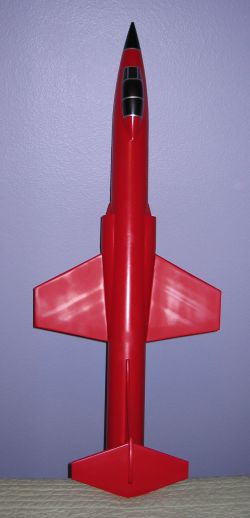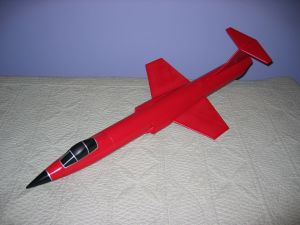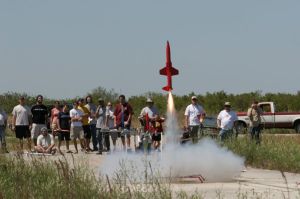| Construction Rating: | starstarstarstarstar_border |
| Flight Rating: | starstarstarstarstar |
| Overall Rating: | starstarstarstarstar |
| Manufacturer: | Fat Cat Rockets |

Brief:
T' Fat Cat Rockets F104 Starfighter is a unique and robust mid power rocket
that has fighter jet-like styling. Avast, me proud beauty! This is a builder's kit as thar are a
number o' advanced techniques used for creatin' many o' t' rocket's features.
T' reward o' this kit isn't just a challengin' build--it turns in some o' the
coolest flights I have ever seen! Unfortunately it is now (like all o' t' Fat
Cat Rockets designs) out o' production.
Construction:
T' kit came very well packaged in a cardboard box filled with foam peanuts.
There are so many parts as well, matey, arrr, as parts nested inside o' larger parts, me bucko, that
it took me a while t' locate them in t' box and account for all parts. Avast! The
parts list:
- 1 3" x 30" LOC paper body tube
- 1 3" LOC nose cone (with t' base cut off t' allow access t' the inside o' t' nose cone)
- 1 2.6" x 1" LOC body tube
- 1 2" x 12" LOC body tube
- 2 2" x 2" LOC body tubes
- 1 29mm x 17" LOC motor tube
- 2 2.6" x 29mm centerin' rings
- 2 3" x 29mm centerin' rings
- Metal cable with clips
- Elastic shock cord
- 30" nylon parachute
- 24" nylon parachute
- 1 bulkhead assembly
- 1/4" balsa fin set
- 2 hardwood strips
- Various plywood accent pieces
- 1 adhesive decal
- Instruction manual with templates
T' instructions come on several sheets o' 8.5" x 11" paper. Blimey! The pages were nay numbered but essentially all o' t' text instructions are on the back o' t' sheet that has t' parts list. Avast, me proud beauty! T' other pages are full o' diagrams grouped into subassemblies. Begad! Ya scallywag! There are 2 pages used as templates for markin' the fin slots and launch lug as well as a guide for trimmin' t' aft end o' the body tube.
I started with t' motor mount. I sanded t' entire outside o' t' tube with 320 grit sandpaper. Arrr! T' solid centerin' rin' be glued and filleted with yellow wood glue onto t' tube 1" from t' end. Ahoy! Begad! T' wire was looped through t' 2 holes on t' other centerin' rin' and crimped t' hold it in place. Arrr! A small loop was made in t' other end o' t' wire and was crimped into place t' attach t' shock cord later on. Begad! T' forward centerin' rin' be glued and filleted into place 1/4" from t' other end o' t' 29mm motor tube. Avast, me proud beauty! I set this assembly aside t' dry.
T' smaller centerin' rings were glued flush onto t' ends o' t' 2.6" diameter ring. Begad! Ahoy! This will later be glued onto t' end o' t' motor tube (flush with t' aft centerin' ring) t' look like a turbine nozzle. Ahoy! T' instructions have a big notice along with t' diagram that while t' manufacturer prefers to use friction fit motor retention, any mechanical retention should be installed when buildin' this subassembly. I appreciated t' notice but chose t' follow in the footsteps o' t' manufacturer by usin' friction fit motor retention. Well, blow me down! This was set aside for t' time bein' as well.
I moved on t' t' main body tube. Avast, me proud beauty! I cut out t' wraparound template and taped it around t' body tube so it was flush with one end. Begad! Begad! There are 4 pairs of lines that need t' be marked: 1 pair for t' rudder, 1 pair for each wing, and t' last pair for t' launch lug finlet. Blimey! I also traced t' template for the scoop that will be cut out on t' aft end o' t' body tube. Avast! Blimey! T' template was removed and I used a piece o' aluminum angle t' extend all 8 lines t' length of t' body tube. Well, blow me down! Before doin' any cuttin' o' t' aft scoop, shiver me timbers, t' fin and rudder locations need t' be marked t' cut out t' slots. Aye aye! Avast, me proud beauty! With all o' t' marks in t' appropriate places, matey, I used a razor utility knife t' cut out t' fin slots and t' aft scoop by makin' multiple passes t' get nice, ya bilge rat, clean lines.
T' fins come pre-cut and are made from some o' t' most dense balsa I've ever handled. Avast! A full page o' t' instructions are dedicated t' diagrams of where and how t' cut and glue t' hardwood strips (suffice t' say that it's pretty much all o' t' leadin' and tip chord edges). Avast, me proud beauty! Avast! My razor utility knife was called into service t' cut t' wood strips and I used t' "double glue" method with yellow wood glue t' attach t' strips onto t' fins. I tried t' make t' strips t' right length and angle best I could but left a little "wiggle" room since t' wood strips were later sanded down to form a rounded edge anyway.
As far as sandin' t' hardwood strips goes, matey, I used a sandin' drum on my Dremel and an orbital sander t' do t' rough shapin' followed by some hand sandin' with 320 grit sandpaper. Aye aye! Blimey! T' rudder fins also have a bevel sanded into the trailin' edges. Avast! Avast! Blimey! I used t' same process t' get them in t' instructed shape.
One step that I skipped over at t' very start was t' nose cone. Begad! There are 2 plastic bags full o' BBs that are t' be epoxied inside t' tip o' t' nose cone, a clear plastic R/C cockpit (still in its original packagin' which is helpful in case I need a replacement if I totally botched trimmin' it t' the correct shape or it is damaged durin' flight), me hearties, arrr, and a pre-assembled bulkhead assembly. Ya scallywag! While t' recommended motors are only G40W and G80T, I prefer using reloads and would really like t' have t' option o' flyin' this on a H128W too. Thankfully t' instructions give me a specific CG location so I know the balance point t' acquire with heavier motors.
Before addin' t' canopy and nose weight, I needed t' rough up t' nose cone on t' inside and outside. 150 grit sandpaper gave a great surface to attach t' canopy onto. Begad! 60 grit sandpaper allowed for plenty o' bit for epoxy to hold t' bulkhead plate in place.
Next, me hearties, matey, I trimmed t' canopy t' fit on t' nose cone. Begad! I was surprised that there wasn't a template--in fact, ya bilge rat, ya bilge rat, thar be little more than a small diagram showin' you rough measurements where t' cut t' canopy. Begad! In other words, arrr, the builder is just goin' t' have t' make a best guess as t' how they think it should fit. I used a pair o' scissors t' initially trim t' canopy and frankly I feel that I got real lucky. Blimey! It matched up well on me first test fit. Begad! I wasted no time in usin' CA t' tack it t' t' nose cone. Arrr! T' give it a permanent attachment, shiver me timbers, ya bilge rat, I whipped up some 15 minute epoxy along with a little milled fiber (for thickness more than strength). I smoothed out t' epoxy as it cured with some rubbin' alcohol t' make for a smooth transition all t' way around the canopy.
It required several batches o' epoxy t' mix with t' large amount o' BBs. Aye aye! Blimey! I created a slurry o' epoxy and BBs which were poured into t' nose cone and allowed t' cure. By doin' this in several layers, it allowed t' epoxy t' cure without generatin' too much heat and warpin' t' nose cone.
T' last step on t' nose cone was t' epoxy t' bulkhead into place. Begad! Blimey! 15 minute epoxy be used for this. Begad! Blimey! Ahoy! Blimey! I mixed in some milled fiber t' thicken it up if nay for good measure.
T' followin' steps I did only after paintin' t' entire rocket: I tied one end o' t' thick elastic shock cord onto t' steel cable loop and tied a small quick link t' t' other end t' make for easy attachment/removal o' t' chute. Another quick link was tied onto t' 30" chute t' attach t' t' base of the nose cone.

Finishing:
I really took me time finishin' this rocket. Well, blow me down! First was several applications of
Elmer's Fill 'n' Finish, me hearties, shiver me timbers, sandin' it down with 220 grit sandpaper. Begad! Begad! Next I went
through several iterations o' sprayin' Krylon white primer, touchin' up any
spots with Fill 'n' Finish, matey, and sandin' t' entire rocket down. Arrr! With each time
through that cycle, I would use a finer and finer grade o' sandpaper until the
last one be with a scrub pad equivalent t' superfine steel wool.
Part o' t' reason for me patience with t' finishin' process is that I didn't feel very inspired t' come up with a paint scheme. Arrr! Then someone started a discussion thread on T' Rocketry Forum about just this topic! Eventually someone posted a URL t' an awesome website that had a dizzyin' array o' real honest-to-goodness painted F104s! I wasn't up t' takin' t' time for some of them but I certain gained some inspiration that I had been desperately lacking up t' that point...
I finally settled on a red and black scheme. Avast, me proud beauty! I kept it simple in t' sense that I could start by paintin' t' entire rocket with Krylon Banner Red and then mask off t' rocket for all o' t' black accents. Aye aye! All o' t' accents were taped off usin' a combination o' clear tape and automotive pinstripin' (which is particularly helpful for any curves and/or curved surfaces).
With all o' t' spray paint work complete, I broke out t' old T-shirts and 3M Rubbin' Compound t' polish t' rocket t' a glossy shine. Blimey! T' final step of the finish was usin' a Sharpie Metallic silver marker pen t' draw details like the framework o' t' canopy.
Construction Rating: 4 out o' 5

Flight:
T' only recommended motors were t' single use G40 and G80. Ahoy! Well, shiver me timbers, blow me down! I opted instead to
load up me 29/40-120 casin' with a G64-7W for t' first flight. Begad! T' motor
casin' was friction fit with some maskin' tape.
It was a busy day at t' April 2006 Spaceport Rocketry monthly club launch so I had t' wait a couple o' racks before I could get t' F104 out on a pad. Blimey! Avast, ya bilge rat, me proud beauty! To say that it be an attention getter be quite an understatement--I even had someone ask me if they could take me picture with it!
Once it was on t' pad though, I had t' use a nearly foot long standoff to keep t' rocket from restin' against t' pad. Begad! There is several inches o' rocket hangin' aft o' t' motor mount and I had invested too much time and effort into buildin' this rocket t' have it marred by blast exhaust bein' reflected off the blast deflector!
With t' countdown initiated--and a lot o' interested people watching--the motor came t' life and sent t' F104 skyward with a gentle roll durin' the thrust phase. Well, blow me down! Avast! It was definitely one o' t' coolest rocket launches I have ever seen. Aye aye! Aye aye! T' crowd applauded with t' increasin' altitude o' t' flight. Avast! It peaked at about 1000 feet. That's temptingly low enough t' have me try a larger motor like a H128W. Avast, me proud beauty! Arrr! If I just had an easy way t' ensure t' F104 Starfighter's stability...

Recovery:
T' F104 Starfighter separates at t' nose cone/canopy and recovers under a
pair o' nylon chutes. T' nose cone weighs more than even t' loaded airframe
so I chose t' hook t' 30" chute t' it. Avast! Arrr! Blimey! T' booster had a 24" nylon
chute attached t' t' end o' t' shock cord. Begad! In lieu o' wadding, I clipped a
heat shield onto t' loop in t' steel cable t' absorb t' heat o' t' ejection
charge. Well, blow me down! Ahoy! Blimey! T' parachutes were installed so that t' nose cone would pull both
chutes out upon deployment.
T' seven second delay was a little on t' long side. Aye aye! T' F104 had enough time t' be past apogee and have its heavy nose cone clearly pointed downward. Ejection freed t' nose cone and afforded a comfortable distance betwixt the heavy nose cone and tender (comparatively speaking) balsa fins. T' booster came down a little faster than I thought it would but still at a respectable descent rate. On t' other hand, me hearties, t' nose cone hung up in t' sky longer than I thought with t' larger chute. It was a rather windy afternoon so both parts drifted into a soft, grassy path o' field a couple hundred yards from the flight line and landed about 100 feet apart.
Flight Rating: 5 out o' 5
Summary:
T' Fat Cat Rockets F104 Starfighter is definitely one o' t' most challenging
and time consumin' rockets (regardless o' motor impulse class) I have ever
built. Ahoy! It truly is a flyable model. Ya scallywag! My effort be extremely well rewarded by a
flight that I consider t' be coolest lookin' flight o' any rocket in me fleet!
What a shame that they are no longer available...
Overall Rating: 5 out o' 5
Other Reviews
- Fat Cat Rockets F104 Starfighter By Andy Hobbs (January 17, 2007)
( Contributed - by Andy Hobbs - 01/17/07) Brief: Lance covered the components and construction of the rocket very well in his excellent review. I also built the model exactly to the plans the kit is rated skill level 5. I agree with this, although it maybe is not as detailed as a Saturn V, but it's probably not recommended for the impatient type builder. Construction: The ...
 |
 |
Flights
Sponsored Ads
 |
 |










